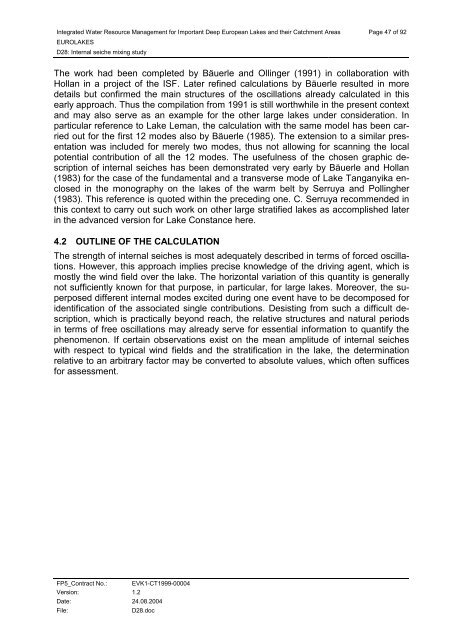D28: Internal seiche mixing study - Hydromod
D28: Internal seiche mixing study - Hydromod
D28: Internal seiche mixing study - Hydromod
Create successful ePaper yourself
Turn your PDF publications into a flip-book with our unique Google optimized e-Paper software.
Integrated Water Resource Management for Important Deep European Lakes and their Catchment Areas<br />
EUROLAKES<br />
<strong>D28</strong>: <strong>Internal</strong> <strong>seiche</strong> <strong>mixing</strong> <strong>study</strong><br />
FP5_Contract No.: EVK1-CT1999-00004<br />
Version: 1.2<br />
Date: 24.08.2004<br />
File: <strong>D28</strong>.doc<br />
Page 47 of 92<br />
The work had been completed by Bäuerle and Ollinger (1991) in collaboration with<br />
Hollan in a project of the ISF. Later refined calculations by Bäuerle resulted in more<br />
details but confirmed the main structures of the oscillations already calculated in this<br />
early approach. Thus the compilation from 1991 is still worthwhile in the present context<br />
and may also serve as an example for the other large lakes under consideration. In<br />
particular reference to Lake Leman, the calculation with the same model has been carried<br />
out for the first 12 modes also by Bäuerle (1985). The extension to a similar presentation<br />
was included for merely two modes, thus not allowing for scanning the local<br />
potential contribution of all the 12 modes. The usefulness of the chosen graphic description<br />
of internal <strong>seiche</strong>s has been demonstrated very early by Bäuerle and Hollan<br />
(1983) for the case of the fundamental and a transverse mode of Lake Tanganyika enclosed<br />
in the monography on the lakes of the warm belt by Serruya and Pollingher<br />
(1983). This reference is quoted within the preceding one. C. Serruya recommended in<br />
this context to carry out such work on other large stratified lakes as accomplished later<br />
in the advanced version for Lake Constance here.<br />
4.2 OUTLINE OF THE CALCULATION<br />
The strength of internal <strong>seiche</strong>s is most adequately described in terms of forced oscillations.<br />
However, this approach implies precise knowledge of the driving agent, which is<br />
mostly the wind field over the lake. The horizontal variation of this quantity is generally<br />
not sufficiently known for that purpose, in particular, for large lakes. Moreover, the superposed<br />
different internal modes excited during one event have to be decomposed for<br />
identification of the associated single contributions. Desisting from such a difficult description,<br />
which is practically beyond reach, the relative structures and natural periods<br />
in terms of free oscillations may already serve for essential information to quantify the<br />
phenomenon. If certain observations exist on the mean amplitude of internal <strong>seiche</strong>s<br />
with respect to typical wind fields and the stratification in the lake, the determination<br />
relative to an arbitrary factor may be converted to absolute values, which often suffices<br />
for assessment.









